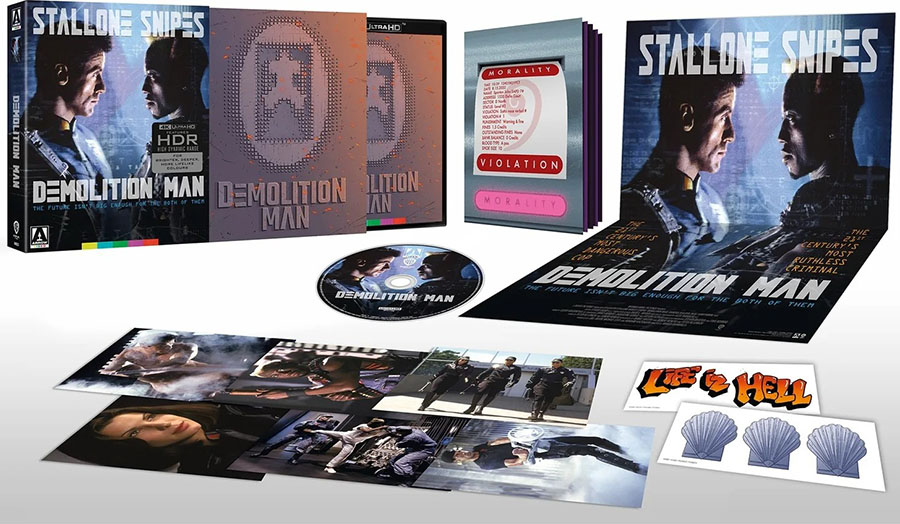REVIEW Back in 1993, the dynamic action star duo of Sylvester Stallone and Wesley Snipes caused chaos on screen in the satirical sci-fi blockbuster now available for the first time in 4K disc home theaters in an extras-packed Demolition Man: Limited Edition (Arrow Video, rated R, 2.39:1 aspect ratio, 115 minutes, $59.99).
The story begins in 1996 in an apocalyptic Los Angeles with law enforcement officer John Spartan, aka Demolition Man (Mr. Stallone), arresting Simon Phoenix (Mr. Snipes) after destroying a building with hostages becoming collateral damage.
Both men are convicted for the civilian deaths and sentenced to existing in a permanent cryogenic state.
Enter 2032, after California was destroyed by an earthquake, to find the utopian state of San Angeles (merging Los Angeles, San Diego, and Santa Barbara) disrupted by the escape of Phoenix during his parole hearing, as the criminal goes on a “murder, death, kill” rampage.
Unable to stop the maniac, San Angeles Police Lt. Lenina Huxley (Sandra Bullock in one of her first film roles) persuades her superiors to defrost Spartan to go after Phoenix.
Of course, waking up a macho man in a civilization that forbids swearing, sexual contact and even casual touching allows for a myriad of humorous exchanges.
Spartan’s rare moment of familiarity comes when getting the chance to eat at Taco Bell, now considered the city’s only fine dining experience.
Suffice it to report, the laughs are often in this out-of-time narrative supplemented with performances by Denis Leary as the leader of an underground rebel group trying to destroy the utopian lifestyle, Nigel Hawthorne as the man who devised the utopia and Glenn Shadix as his flamboyant assistant.
Now bundle the clever script and silly acting within some typical extreme Stallone action scenes and viewers will get, as a San Angeles citizen might say, “joy-joy” feelings within an evening of entertainment.
4K in action: A brand new 4K restoration from the original 35mm camera negative by Arrow Films, approved by director Marco Brambilla, offers a detailed and colorful glimpse into the old and new Los Angeles area.
Explosions sizzle from the screen with impressive clarity, and scenes to examine include when any time futuristic prototype cars are on the roads versus Spartan driving that cherry red and immaculate 1970 Oldsmobile 442 W-30 or a wild firefight in a history museum.
A reference quality moment to appreciate showcases the effects team handling the eventual demise of a frozen villain, decapitated and shattered into tiny pieces.
Best extras: Arrow overwhelms owners in this overloaded edition with three optional commentary tracks starting with new analysis from Mr. Brambilla and screenwriter Daniel Waters loaded with nostalgic enthusiasm.
They talk nearly nonstop and provide details such as the COVID pandemic helped make this movie a classic today (no toilet paper, no touching); the prisoner freezing effect was inspired by the substance ice-nine from Kurt Vonnegut’s “Cat’s Cradle”; and Mr. Waters takes full credit for the “first severed eye to open a door” gag now seen in other films.
Next, a new encyclopedic track has film historian Mike White of the Projection Booth podcast reading quotes from the film crew; touching on themes, the cast credits and comparable films using the “man out of time” trope; and mentioning the movie title was inspired from the track in The Police’s fourth album “Ghost in the Machine” — all delivered in the style of a term-paper dissertation.
A final vintage, essentially solo, track offers Mr. Brambilla with just a pinch of banter with producer Joel Silver from 2011. Besides lots of solid production information from the director, the most memorable moments are mentions of deleted scenes that are still yet to be seen in any “Demolition Man” home entertainment release.
Equally insightful is a new visual essay by film historian Josh Nelson explaining how the Rodney King riots were a referential source for the fiery downfall of Los Angeles in the film. He also shows how the movie’s themes tapped into both liberal as well as conservative versions of utopia.
Next, a new 14-minute interview with production designer David Snyder, the same guy who helped bring the “Blade Runner” universe to life, sheds light on his work on “Demolition Man.” Highlights include blowing up a real abandoned school building for the opening sequence, building an 80-foot-tall set for the history museum’s Hall of Violence and immersing the actors in hair gel in the cryogenic cells in the prison.
Viewers also get new interviews with stunt coordinator Charles Percini (six minutes), who says he loved working with Mr. Stallone; special make-up effects artist Chris Biggs (six minutes) expounding on making an eyeball; and body effects set coordinator Jeff Farley (10 minutes) on creating fake humans for the cryogenic prison facility highlighted by a nude John Spartan.
If that was not enough, viewers even get two versions of the film, the U.S. cut using Taco Bell for fine dining and the international version that promoted Pizza Hut as the hip foodie experience in San Angeles.
The slipcover package innards also shine beginning with a 60-page bound booklet with color photos throughout and new essays by film critics Clem Bastow, William Bibbiani, Priscilla Page and Martyn Pedler.
Arrow also includes a double-sided poster (16 inches by 20 inches) featuring a reproduction of the original movie poster and newly commissioned artwork by Laurie Greasley; six double-sided, postcard-sized movie photo cards; and even stickers of the mysterious three clam shells and “life is hell” graffiti.
• Joseph Szadkowski can be reached at jszadkowski@washingtontimes.com.




Please read our comment policy before commenting.